A journey of a thousand miles begins with a single step. Rupa’s journey began in 1968, when the domestic innerwear market was totally unorganised.
Rupa & Company Ltd., the Kolkata-based hosiery company founded by the first generation entrepreneurs, Mr. Prahlad Rai Agarwala, Mr. Ghanshyam Prasad Agarwala and Mr. Kunj Bihari Agarwal, has moved from strength to strength since inception in 1968 and has established itself as India’s largest knitwear brand. It specialises in different product categories like innerwear, casualwear, kidswear, winterwear and footwear. These products have been catering to the rising demand of the Indian knitwear and fashionwear industry for decades. The company’s iconic boutique of brand includes Jon, Frontline, Euro, Bumchums, Torrido, Thermocot, Softline, Macroman, Macroman M-Series, Macrowoman W-Series and Footline.

The company founders said: “When we began in 1968, the domestic hosiery was highly unorganised and was dominated by small players who were only manufacturing men’s innerwear. We seized the opportunity by predicting growing demand for quality and branded innerwear products. This led us towards the formation of our own brand “Rupa”. Since then, there was no looking back. We had been successful in entering the market dominated by the unorganized sector and bringing in the discipline of the organized sector, thereby enhancing the consumer experience and widening the market share of the company”.
Change is the only constant. At 50, Rupa transformed itself in response to the changing realities. Today the brand “Rupa” is a powerful blend of a range of traits: rich multi-sectoral insight, drive for innovation, a fashionable product mix that reflects evolving customer aspirations, a pool of budding and talented employees, a dedicated network of distributors & dealers, and a widening market penetration. These attributes have created a fast-paced, resilient and reinvigorated brand over the last five decades.
“At Rupa, we are attractively positioned to address the opportunities for a number of reasons: we believe that the secret of the company’s success has been its ability to keep innovating to create and deliver superior products and, more importantly, the power of its brands to connect with consumers in providing an unparalleled fashion experience. They continue to emphasise the ‘value-for-money’ proposition and address the everyday needs of people everywhere. It is our conviction that the chemistry between these factors will lead to sustainable revenues and surpluses in the coming years”, they added.

Building a strong organization
Rupa commands a dominant market share in the organized retail segment of the knitwear and hosiery industry. Going ahead, the company is quite optimistic of sustaining its growth for some interesting reasons.
Rupa was traditionally a hosiery company, but its gradual shift from single product dependence to multi-layer offerings, including specialised women’s wear, kid’s wear, casual wear and fashion wear across super-premium, premium, medium, and economy segments has created a niche for the company in the market.
The licensing agreement between Rupa’s wholly-owned subsidiary with “FCUK” and “Fruit of the Loom” to manufacture, distribute, advertise and sell their innerwear and outwear products in India is going to be a game changer for Rupa and is expected to add to the company’s revenue in the long run and endorse the image of the group in the super premium segment.
Rupa is also the first company in India from SUPIMA to make quality innerwear products made of qualitative American Pima cotton. It continues investing in manufacturing facilities either proximate to markets of consumption or in fiscal-friendly locations. Today its manufacturing facilities are situated at Domjur, Tirupur, Bengaluru and Ghaziabad and sales offices are at major locations like Kolkata, Patna, Mumbai, Delhi, Ghaziabad, Bengaluru and Tirupur.
Innerwear market
The Indian innerwear industry is highly unorganized with unorganized players having almost a 50% market share. The implementation of the GST system has been a major positive for organized players. Innerwear appears to be a potential growth category. The men’s innerwear market contributes 40% and is characterized by the presence of numerous Indian and international brands. The economy segment contributes around 56% in the men’s wear market, the mid-price segment 30% and the remaining 14% comes from premium and super-premium segments. Further, the premium and super-premium segments are expected to grow at a faster pace.
The women’s innerwear market, which is driven by value-added products, contributes around 60% to the market and is growing at a faster rate of 15%. The market is largely dominated by mid-priced and economy segment contributing 80% of the market, while the rest comes from the premium and super premium segments.
The company believes that the industry is 50% unorganized and expects shift to happen from the unorganized to an organized one in the long run. Increasing urbanization, shift towards branded products, introduction of GST, organized and online retailing, etc., are factors driving growth for organized players.
Rupa is focusing on enhancing its product offering in the children and women’s segment with the introduction of new products and brands. It is also looking to foray into the women’s lingerie segment and is looking for a tie-up for the purpose. Both the children and women’s segment have a lower presence of organized players and hence, provide a huge opportunity for the company.
The Indian innerwear market is shifting from a price sensitive to a fashion-oriented market. Accordingly, the group is gradually increasing its presence in the premium segment with direct and indirect strategic tie-ups with foreign brands.
Rupa achieved a turnover of Rs. 1,126.11 crores in 2017-18. It has over 18 sub-brands and 8,000 stock keeping units (SKUs) with a strong brand recall. It has its pan-India presence with a large distribution network consisting of four central warehouses, 10 exclusive brand outlets (EBOs), more than 1,000 dealers and 1,25,000 retailers. It is also looking at enhancing availability through presence in e-commerce, multi-brand outlets (MBOs) and large format retail stores (LFRs).
The company is also looking forward to open Rupa EBOs through the franchisee route across India and expand its retail footprint.